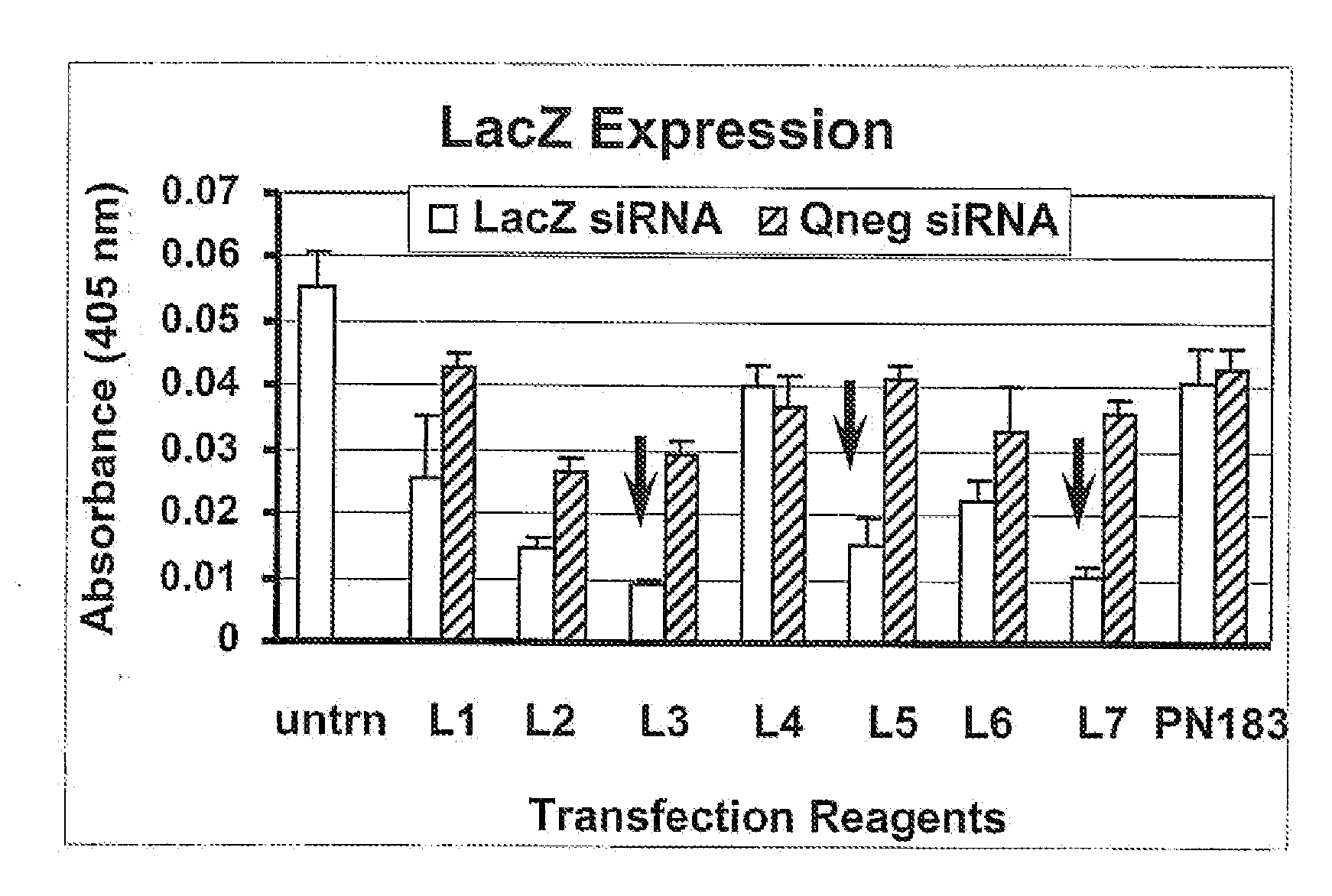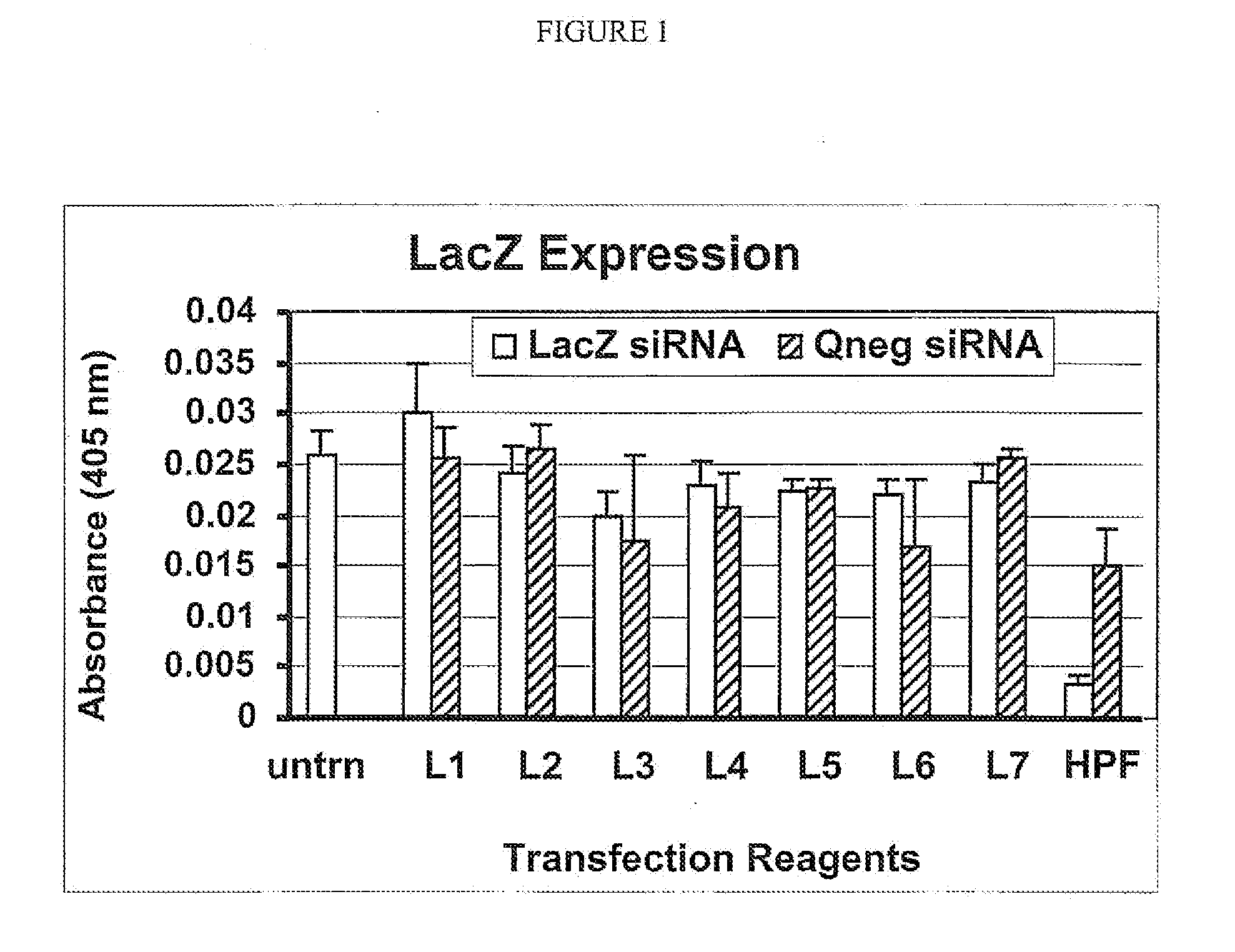COMPOSITIONS AND METHODS FOR LIPID AND POLYPEPTIDE BASED siRNA INTRACELLULAR DELIVERY
a polypeptide and lipid technology, applied in biochemistry apparatus and processes, fermentation, gene material ingredients, etc., can solve the problems of poor gene-transfer efficiency of electroporation, limited clinical application, and pathogenicity
- Summary
- Abstract
- Description
- Claims
- Application Information
AI Technical Summary
Problems solved by technology
Method used
Image
Examples
example 1
Materials and Methods Used
[0164]The present example illustrates the materials and methods used to assess the efficacy of the one or more non-cationic lipids or a combination of a non-cationic lipid and a cationic lipid and polypeptide mixture to enhance siRNA cell-uptake and permit siRNA mediated target gene knockdown activities in vitro. Cell viability was also assessed. The cell culture conditions and protocols for each assay are explained below in detail.
Materials
[0165]Table 2 below shows the materials and their source used in the instant application. Both the LacZ siRNA (gactacacaaatcagcgattt (SEQ ID NO: 33)) and Qneg siRNA (uucuccgaacgugucacgu (SEQ ID NO: 34)) were from QIAGEN™. The Qneg siRNA served as a negative control and was labeled with Alexa 546 at the 3′-end of sense strand. The 9L / LacZ cell line was obtained from the American Type Culture Collection (ATCC™). The amino acid sequence of the polynucleotide-delivery enhancing peptide PN73 is as follows:
(SEQ ID NO: 35)NH2-K...
example 2
Efficient Cellular Uptake of siRNA in the Presence of a Non-Cationic Lipid and Polypeptide
[0171]The present example demonstrates that efficient siRNA cellular uptake is achieved when the siRNA is combined with a non-cationic lipid and an exemplary polypeptide. The transfection efficiency of siRNA achieved with anionic lipids, neutral lipids and a combination of an anionic and / or neutral lipid with the exemplary polypeptide was compared. Further, the effect of each transfection condition on cell growth was also analyzed.
[0172]For the instant example, the Qneg siRNA was conjugated with the fluorescent tag Alexa 546 at the 3′-end of the sense strand in order to visualize its cellular location by microscopy. Table 3 below illustrates the different lipids used alone or in combination to transfect siRNA. If different lipids were used in combination, their respective ratio is also shown. In the instant example, DOPE (1,2-Dioleoyl-sn-Glycero-3-Phosphoethanolamine) and Cholesterol were used ...
example 3
Effective In Vitro Knockdown of β-Galactosidase Activity by a LacZ siRNA Transfected with an Exemplary Polypeptide and Non-Cationic Lipid Delivery Vehicle
[0179]The present example demonstrates that siRNA transfected with one or more non-cationic lipids and exemplary polypeptide combination effectively reduces the activity of the gene product of the transcript targeted for degradation by the siRNA in vitro. This result is in contrast to the failure of the siRNA to knockdown the activity of the gene product of the transcript targeted for degradation by the siRNA when the siRNA is transfected with one or more non-cationic lipids without the exemplary polypeptide.
[0180]The present example is distinguished from prior Example 2 in that it describes transfection conditions that permit efficient functionality of siRNA (i.e., mediated degradation of a target RNA) within the cell after intracellular delivery (transfection). The prior Example 2 measured the ability of the siRNA to enter the ce...
PUM
| Property | Measurement | Unit |
|---|---|---|
| molecular weight | aaaaa | aaaaa |
| pH | aaaaa | aaaaa |
| concentration | aaaaa | aaaaa |
Abstract
Description
Claims
Application Information
 Login to View More
Login to View More - R&D
- Intellectual Property
- Life Sciences
- Materials
- Tech Scout
- Unparalleled Data Quality
- Higher Quality Content
- 60% Fewer Hallucinations
Browse by: Latest US Patents, China's latest patents, Technical Efficacy Thesaurus, Application Domain, Technology Topic, Popular Technical Reports.
© 2025 PatSnap. All rights reserved.Legal|Privacy policy|Modern Slavery Act Transparency Statement|Sitemap|About US| Contact US: help@patsnap.com



